
THE Top End is adventure country, a land of vast monsoon forests, floodplains, far horizons, escarpments and muddy, crocodile-invested tidal streams.
Pine Creek is the gateway to this challenging landscape. From this historic rail and mining village there is a choice of continuing north to Darwin on the Stuart Highway, or east via the Kakadu Highway to Cahills Crossing on the East Alligator River.
It intersects with the Arnhem Highway at Jabiru. The combination of the Stuart, Kakadu and Arnhem Highways is a 700km circuit adventure drive from Pine Creek. Okay, die-hard 4WDers will cry out that these roads are sealed, but these highways offer some of the best adventure escapes you can experience, and you don’t need corrugated bulldust tracks to have fun.
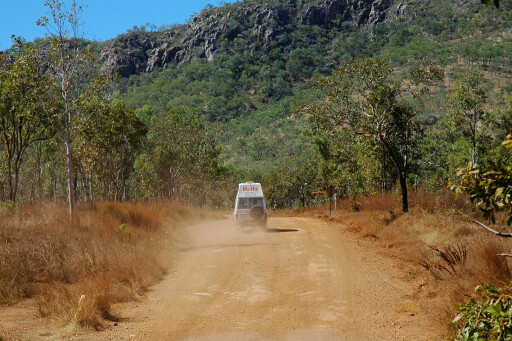 Back in the early 1960s, the only way into the Alligator River country in a vehicle was from Pine Creek. A mate and I did it in an old Series 1 Land Rover – a dusty, bone-jarring journey that took three days; though, it would have taken less time if we didn’t share a few bottles of rum with fellow travellers we met en route, including barramundi fishers, buffalo hunters, poachers, rangers and two Pine Creek coppers on patrol.
Back in the early 1960s, the only way into the Alligator River country in a vehicle was from Pine Creek. A mate and I did it in an old Series 1 Land Rover – a dusty, bone-jarring journey that took three days; though, it would have taken less time if we didn’t share a few bottles of rum with fellow travellers we met en route, including barramundi fishers, buffalo hunters, poachers, rangers and two Pine Creek coppers on patrol.
In 1979, the Ranger Uranium Mine Agreement saw the development of the first stage of the Kakadu National Park. Two other stages were added to it in the 1980s, making it Australia’s largest national park at 20,000km². Kakadu is a World Heritage Area-listed park, recognised for its cultural and natural heritage.
It attracts visitors from all over the world, which, along with the Ranger Mine operation, was enough of a reason to seal the old Pine Creek to the East Alligator River in the 1990s. The Arnhem Highway was planned in the late 1960s when uranium was discovered in the Alligator Rivers Province, and it was sealed in the 1970s.
While the dusty road no longer exists, the circuit provided by the three highways has opened up country that was impassable with even the best-equipped 4WD of the day prior to the 1960s. In case you’re wondering, there are still plenty of dirt side-tracks that end at stream pools, billabongs and swamps.
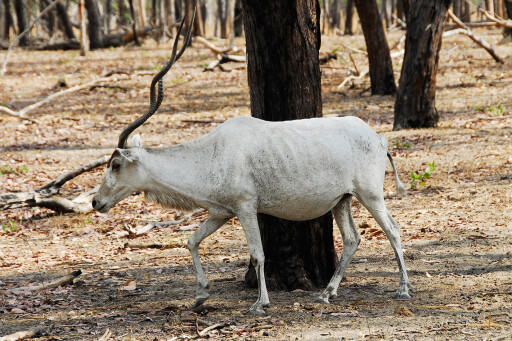 Just to the east of Pine Creek is the Northern Goldfields Loop, an 81km drive that takes you past the ruins of historic towns and abandoned mines. It’s wild, hilly country ruled by buffalo, wallaroos and brumbies. About 70km from Pine Creek is the Mary River Roadhouse, where the entrance to the park is about two kilometres up the road. Take El Sherana Road to Gumlom and Koolpin Gorge, which runs past the Ranger Station.
Just to the east of Pine Creek is the Northern Goldfields Loop, an 81km drive that takes you past the ruins of historic towns and abandoned mines. It’s wild, hilly country ruled by buffalo, wallaroos and brumbies. About 70km from Pine Creek is the Mary River Roadhouse, where the entrance to the park is about two kilometres up the road. Take El Sherana Road to Gumlom and Koolpin Gorge, which runs past the Ranger Station.
The road is rarely maintained and often badly corrugated, but the rewards at its end make it well worth the drive, especially when under the high walls of the Arnhem Land Escarpment that looms high above the trees. At Gumlom, there’s a management camping area that has an ablution block with showers and toilets, and all Kakadu-managed camps have an on-site manager who collects camping fees.
The escarpment plateau features sandstone shelters at its base, where the many outliers that rise above the woodlands house an incredible number of rock-art galleries. Some are open to the public, while others are strictly out of bounds.
A big plunge pool at the base of Waterfall Creek at Gumlom was made popular by the first Crocodile Dundee movie, when Mick Dundee speared the barramundi while impressing his lady friend. People swim here; though, in my experience, having lived in Kakadu for 10 years, the only safe waterhole is on top of the escarpment at Jabiru. Remember that the Top End is crocodile country.
BARRAMUNDI COUNTRY
IF YOU love fishing, it’s time to unwind the gear and catch a barra – as you’ve arrived in barramundi country. The Yellow Water Billabong has some of the best freshwater fishing in Kakadu, with the opportunity to lure barramundi, saratoga and tarpon. It’s recommended to release your fish, because billabong barra have a weedy taste and aren’t great to eat.
If you must, soak the skinned fillets in a strong brine solution for 30 minutes, then dry and store. Beware that crocodiles in this part of the world have no fear of you and may attempt to steal your fish (or you).
Punters without a tinnie can sign up to a Yellow Water Cruise, which flows right into the heart of the swamp, past basking crocodiles, whistling ducks, radjah shelducks, water-walking lotus birds, jabirus and diving sea eagles. The wildlife is truly amazing, and if you ever wanted to swim in a Kakadu waterhole, this cruise will inspire you not to.
More attractions, campgrounds, lookouts and bird-rich, lily-clad billabongs are located further up the highway. However, we’d advise against picking the lilies or you will end up on the front page of an NT newspaper (again, remember this is crocodile country).
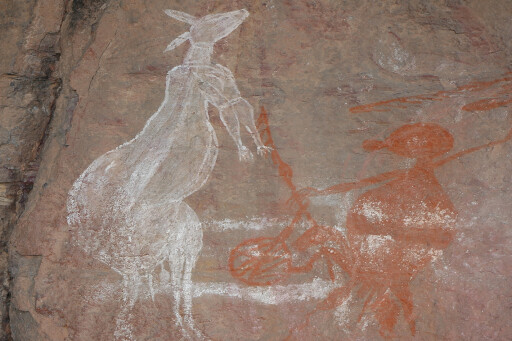 Muirella Park hosts one of the nicest campgrounds in Kakadu, and a little farther is Nourlangie Rock, an outlier that features the most amazing rock art in Australia. The many galleries house the spirit beings of the dreamtime who created the land and still rule the weather. For the fit, there are several long walks in the Nourlangie Rock area, but let someone know what you are doing and carry plenty of drinking water. This wilderness is not kind to the unwary or stupid.
Muirella Park hosts one of the nicest campgrounds in Kakadu, and a little farther is Nourlangie Rock, an outlier that features the most amazing rock art in Australia. The many galleries house the spirit beings of the dreamtime who created the land and still rule the weather. For the fit, there are several long walks in the Nourlangie Rock area, but let someone know what you are doing and carry plenty of drinking water. This wilderness is not kind to the unwary or stupid.
A 58km section of the Kakadu Highway, from the Arnhem Highway to Cahills Crossing, completes the drive. It’s a truly invigorating journey that provides the best views of both wetlands and escarpment stone country in Kakadu. Check with the Northern Land Council Office at Jabiru for a permit to Gumbalanya into Arnhem Land proper.
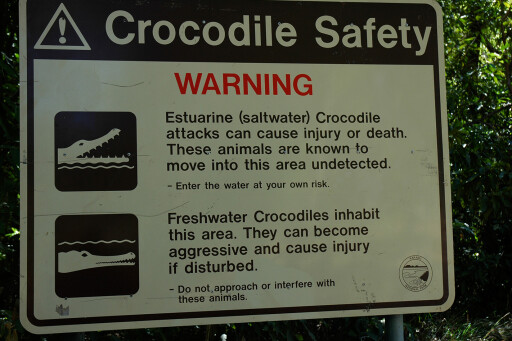 The community has an amazing local art gallery and is well worth an excuse to see the escarpment and billabong country. Before you get there, though, you must run the gauntlet of local crocodiles that laze near Cahills Crossing on the East Alligator River. When the muddy tide flows in, it pushes diamond-scale mullet up against the crossing. They are hammered by barramundi, which in turn are hammered by anglers, who are hammered by crocodiles.
The community has an amazing local art gallery and is well worth an excuse to see the escarpment and billabong country. Before you get there, though, you must run the gauntlet of local crocodiles that laze near Cahills Crossing on the East Alligator River. When the muddy tide flows in, it pushes diamond-scale mullet up against the crossing. They are hammered by barramundi, which in turn are hammered by anglers, who are hammered by crocodiles.
There is a managed campground nearby, as well as the world-famous Ubirr rock-art galleries. Beautiful panoramic vistas from the top of the rock, where the floodplains of the river extend far to the north, are on offer. With good fishing and bushwalks, the East Alligator River is well worth a few days of relaxation.
There are many vehicle tracks in the undeveloped northern parts of the park, so check with the staff at the Bowali Visitors Centre for access and permits. It’s very remote, wild country bisected by billabongs, woodlands, floodplains and rushing springs.
THE ARNHEM HIGHWAY
THERE is 250km of adventure en route to Darwin from Jabiru. After resupplying at Jabiru, stop and visit the Mamukala Wetlands and the boat ramp at the South Alligator River. If you have a boat, the river has a lot of good fishing.
The Aurora Kakadu resort, just down the highway, is a top spot to relax, bush walk, or from which to take day trips to the Red Lily and Alligator Billabong complexes to the south. The West Alligator Head Track is a short distance from the resort and is one of the most underrated destinations in the park.
En route, travellers have the choice of camping and fishing on several billabongs and pools in the Wildman River, or they can camp near a huge coastal swamp that overlooks Van Diemen Gulf. There are no facilities and, apart from fishers and birdwatchers, few people ever go there. Note: these tracks rarely open before July, as they traverse several wetlands.
Heading west, the partly-sealed Shady Camp road has several turn-offs including those to Rockhole and Carmor Plains Wildlife Reserve. This is true floodplain country clad with bird-rich wetlands, billabongs and the best land-based fishing spot in the Top End, the Shady Camp Barrage.
The wetland is all part of the Mary River system, and it’s rated as the most beautiful in tropical Australia. The river – we crossed it upstream on the Kakadu Highway – loses its identity below Corroboree Billabong, where it overflows into two creeks, Tommycut and Sampan.
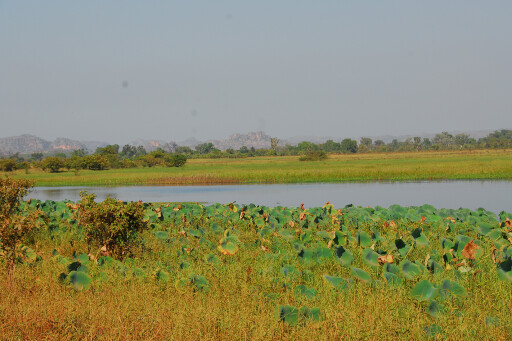 The latter was dammed in the 1980s in an effort to stop the tides from flooding the freshwater wetlands. The dam is similar to Cahills Crossing, as fish on incoming tides are trapped between the wall and the predators. The fishing from the wall and the creek bank is amazing in the wet season, as the barra, tailed by hordes of hungry crocodiles, simply jump onto your hook.
The latter was dammed in the 1980s in an effort to stop the tides from flooding the freshwater wetlands. The dam is similar to Cahills Crossing, as fish on incoming tides are trapped between the wall and the predators. The fishing from the wall and the creek bank is amazing in the wet season, as the barra, tailed by hordes of hungry crocodiles, simply jump onto your hook.
Back on Kakadu Highway, the Mary River Park and Bark Hut Tourism Centre are situated on the east bank of the river, and both offer comfortable accommodation. There is a picnic day area and a boat ramp on the Mary River Lagoon, while a bush track closely follows the river downstream and takes in billabongs and river pools, before it joins the Rockhole track from Shady Camp Road.
It’s an amazing wildlife route, but it’s only open late in the dry season. A little farther west is the turn-off to Hardies Lagoon, which takes you across woody hills where antilopine wallaroos frolic. The lagoon has bush camping and a boat ramp, and it’s a nice spot to unwind and relax.
The next turn-off is to the famed Corroboree Billabong – there’s no other billabong like it in the Top End. It has 18km of navigable waters, housing a visible display of birdlife and crocodile numbers unmatched anywhere else. It’s the only place (I know of) where both freshwater and saltwater crocodiles bask side by side, and there are enough fish in the billabong to keep both species happy.
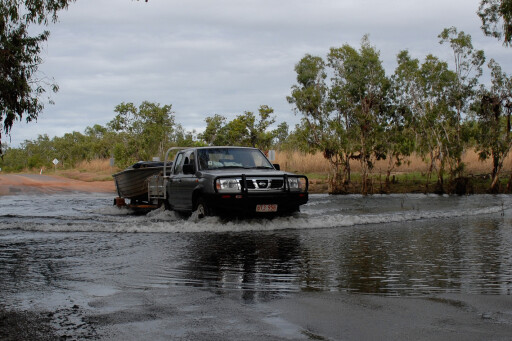 For something different, hire one of the houseboats that ply the waters and spend a night surrounded by fish, crocodiles, waterfowl and dingoes. Corroboree Park has accommodation, camping, fuel and meals, and the entrance to Djukbinj National Park is just down the road.
For something different, hire one of the houseboats that ply the waters and spend a night surrounded by fish, crocodiles, waterfowl and dingoes. Corroboree Park has accommodation, camping, fuel and meals, and the entrance to Djukbinj National Park is just down the road.
This park is under-utilised by visitors in their rush to get to Kakadu, but it has nice bush campsites scattered along verdant creeks, floodplains, patches of true monsoon rainforest and tall woodlands. Down the road, the Adelaide Crocodile Cruise Centre provides crocodile cruises along the river.
It’s a big operation, with another company sited downstream, which is reached past the Windows on the Wetlands – an information complex sited on the highly visible Beatrice Hill, which provides 360-degree views of the wetlands. The centre has amazing interpretive displays of the region that covers flora, fauna and local history.
 From Beatrice Hill, take the Fogg Dam turn-off. The dam, built just after World War II, was one of several designed to provide water to grow rice on the floodplains, but the project failed when millions of magpie geese ate the crop. The army was called in to help and machine-gunned the birds, but to no avail, as the geese outnumbered the bullets.
From Beatrice Hill, take the Fogg Dam turn-off. The dam, built just after World War II, was one of several designed to provide water to grow rice on the floodplains, but the project failed when millions of magpie geese ate the crop. The army was called in to help and machine-gunned the birds, but to no avail, as the geese outnumbered the bullets.
Huge pumps on the Adelaide River pumped water at low tide into the holding dams. However, every time they were switched on, Darwin suffered a power outage – so most of the dams were later destroyed to restore the land.
Continue on the dirt road from Fogg Dam across the floodplains to the original Adelaide River Cruises operation. The personalised operation uses small boats that carry only 20 people, who are seated at water level. Once on the river, they’ll come face to face with some of the biggest crocodiles in the Top End. But never fear, as protection is afforded via screens.
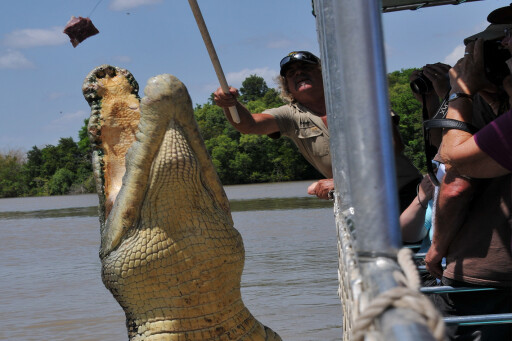 The Adelaide River is the only place in tropical Australia where cruise operators are allowed to feed crocodiles in the wild. It is banned elsewhere, apart from wildlife parks. As this is no park, you will never experience anything like it elsewhere.
The Adelaide River is the only place in tropical Australia where cruise operators are allowed to feed crocodiles in the wild. It is banned elsewhere, apart from wildlife parks. As this is no park, you will never experience anything like it elsewhere.
A few kilometres later you’ll drive into busy Humpty Doo. If you’re a pub crawler, pop in to the local pub for the chance to meet local barflies and hear their tall tales. That is pub life for you!
After a quick ale, you’ll be back on the Stuart Highway where the volume of traffic will make you wish you were back in the bush. It’s followed by an urge to turn back and do it again. Hell, why not?

COMMENTS